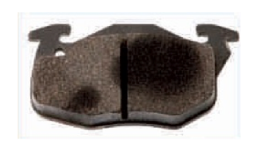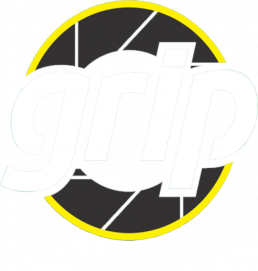FAQ
PAD CONTAMINATION

Appearance:
- Friction material is contaminated with either oil, grease or brake fluid.
Cause:
- Spillage during maintenance, or fluid that has leaked from the caliper.
Effect:
- The vehicle puffs to one side during braking.
- Reduction in braking performance.
Remedy:
- Identify and repair cause of contamination.
- Replace the brake pad set.
GLAZING
Appearance:
- The brake pad friction material is glazed.
Cause:
- High intermittent pad temperature over short time periods.
- Overly harsh braking during the bedding-in period.
Effect:
- Temporary reductions in brake performance.
Remedy:
- If light glazing is evident, no action required.
- If heavy glazing is evident, replace brake pad set.
- Check the disc condition.
UNEVEN WEAR - WEAR LIP
Appearance:
- Uneven wear on the pad surface.
Cause:
- An irregularly worn brake disc or wear lip on the disc cause this pattern of wear on the brake pad.
Effect:
- Squeal and judder.
- Premature pad wear.
Cause:
- Replace brake discs and pads.
BACK PLATE DAMAGE
Appearance:
- Damaged backplate.
Cause:
- Incorrect assembly.
- Excessive force used during fitting.
Effect:
- Braking efficiency.
- Irregular pad wear.
- Noise & judder.
Remedy:
- Replace the brake pad set.
UNEVEN WEAR WITHIN A SET
Appearance:
- One or more brake pads within an axle set is excessively worn.
Cause:
- The caliper guide pins or piston is sticking.
Effect:
- The brake pulls to one side.
- Uneven & overly rapid pad wear.
Remedy:
- Maintain all caliper slides and pistons.
- Replace pads and check replace discs if necessary.
RUSTY PADS
Appearance:
- Rust between the friction material and back plate.
Cause:
- A brake pad sticking in the caliper bracket when braking flexes the back plate, crackling the friction material.
- Corrosion worsens this, separating the friction material and back plate.
Effect:
- Noise and soft pedal feel.
- Once material has separated, brakes will not work.
Remedy:
- Replace brake pad set.
- Clean and maintain caliper to ensure the pad fits freely into the caliper during installation.
TAPERED PADS
Appearance:
- Uneven wear or tapered pads.
Cause:
- The caliper is distorted and the caliper slides are sticking.
- Excessive caliper clearance.
Effect:
- Premature pad wear and noise while braking.
- Uneven braking pressure.
Remedy:
- Replace pad set.
- Maintain and service caliper.
Note: Some vehicles use pads that are tapered by design.
INCORRECT PAD FITTING
Appearance:
- Damaged pads
Cause:
- These "handed" pads are not identical to each other within the set, and need to be fitted to either the inner or outer side of the caliper
- then fitted incorrectly, the pads will be damaged.
Effect:
- Damaged pads.
- Reduced brake performance.
Remedy:
- Replace pad set to manufacturer's instructions as per the inserted diagram.
UNEVEN WEAR-DISC SCORING
Appearance:
- Uneven wear pattern on the pad.
Cause:
- Incomplete contact between brake pad and disc.
- Disc scoring due to dust or excessive wear.
- New pads fitted to worn disc may also cause this.
Effect:
- Squeal and judder.
- Braking efficiency.
Remedy:
- Replace both brake pads and brake discs.
DENATURING
Appearance:
- Partially charred or burnt friction material. (will show whitish outer edges)
Cause:
- Prolonged excessive pad temperature due to intensive use or dragging or the brake pad on the disc
Effect:
- Reduction in initial brake efficiency.
- Excessive material deterioration and abnormal wear.
- Material becomes brittle, chips and cracks.
Remedy:
- Investigate cause for overheating of brake pad.
- If damaged is not excessive, pads will be effective under normal use.
- If damage is extensive replace brake pad set.
CRACKED PADS
Appearance:
- Small cracks in the center if the pad.
Cause:
- The crack indicate that the caliper is sticking.
- The piston bends the back plate causing the back plate to flex, cracking the friction material.
Effect:
- Noise while braking.
- Uneven Pad wear.
- Vehicle pulling to one side during braking.
- Overheating on 1 side of the vehicle.
Remedy:
- Maintain and service the caliper.
- Replace the brake pad.
EDGE CRUMBLING
Appearance:
- Uneven wear pattern on the pad.
Cause:
- Brake pad is sticking within the caliper causing the brake pad to stay in contact with the disc with associated excessive pad temperature.
Effect:
- Pad surface may glaze reducing brake performance.
Remedy:
- Investigate cause of caliper sticking
- Maintain the caliper.
- Replace the brake pad.
WORN OUT PADS
Appearance:
- The friction material is completely worn out.
Cause:
- There has been no regular check of pad wear or proper brake maintenance.
Effect:
- The vehicle pulls to one side during braking.
- Damage to the disc.
- High squeal and other brake noise.
Remedy:
- Check the disc for damage.
- Replace pad set and the disc if it has suffered damage.
METAL PICK UP
Appearance:
- Metal pick-up (or ingrained metal) on the friction surface.
Cause:
- During normal braking small particles of the disc surface break off.
- During extremely wet conditions these are quenched, cooled fast to solid material, and adhere to the brake pad surface.
Effect:
- This generally has no detrimental effect on braking performance, however in extreme cases, it can cause disc damage or brake squeal.
Remedy:
- In extreme cases, replace discs and pads.
